Is Bone Grafting Safe? Risks & Success Rates

Even with constant medical breakthroughs, bone grafting remains crucial. This technique, over a century old, is vital in surgeries today, especially in dentistry where over half a million bone grafts are done each year in the U.S. alone. Many wonder about its safety, the risks involved, and its success rate. These concerns are valid for both doctors and informed patients.
Bone grafting repairs and rebuilds bones by transplanting bone tissue. It is essential for dental implants and fixing oral health issues from bone loss. Though it’s generally safe, risks such as infection, bleeding, and nerve damage exist. Smoking and diabetes might lower the success rate. Yet, careful material choice and post-op care can enhance success.
There are many layers to bone grafting, sparking questions about patient suitability, risk factors, and how new science helps. It’s critical to understand these details to ensure everyone gets the safest, most effective care.
Key Takeaways
- Bone grafting is a critical procedure in the repair of bones, particularly for dental implants and bone loss treatment.
- It is considered safe, but awareness of bone grafting risks is essential for optimal care and patient education.
- Factors such as patient health conditions, like smoking or diabetes, can influence the bone grafting success rate.
- Understanding the potential complications is vital, including the risks of infection, nerve damage, and anesthesia issues.
- Success is contingent on proper graft material selection, post-operative care, and technological advancements in regenerative medicine.
Understanding Bone Grafting
Bone grafting is key in regenerative medicine. It helps fix bone defects and aids in healing fractures. Knowing the bone graft types, bone graft procedure, and bone graft indications helps doctors pick the right treatment for each patient. This ensures the best healing results.
What is Bone Grafting?
Bone grafting means replacing or adding to damaged or missing bone. It helps new bone form and fixes bones hurt by injury or surgery. A bone graft serves as a base for natural bone to grow on. It gets replaced by the body’s own tissue over time.
Types of Bone Grafts
There are different bone grafts, each with its own uses:
- Autografts: Tissue moved from one part of the body to another. Taken from ribs, hips, or wrist, these have a low chance of being rejected.
- Allografts: Taken from a donor of the same species. They are made safe to use and are good when a lot of bone is needed.
- Synthetic Grafts: Made of man-made materials that help grow natural bone. Used when there is not enough natural bone available.
Indications for Bone Grafting
| Condition | Indication for Bone Graft |
|---|---|
| Non-healing fractures | Provide support and help with bone healing and growth |
| Significant bone loss from injury | Replace lost bone and help with stability |
| Osteonecrosis | Better blood supply and bone health |
| Bone tumors | Fix bone strength after tumor is removed |
| Spinal conditions | Make the spine stable or help with spinal fusion |
Bone grafting is very important in orthopedics, dentistry, and other surgeries. It helps bones heal and grow better. Knowing about different grafts, how they’re used, and when helps plan the best treatment.
How Bone Grafting Works
Bone grafting is a high-level medical process. It’s key for many bone and dental fixes. It involves putting bone material into the needed area. Knowing the main parts of this process, how one recovers, and how cells regrow is crucial. Both doctors and patients should understand this.
The Procedure Explained
The bone grafting starts with getting the site ready and getting the bone. This bone might come from the patient (autograft) or a donor (allograft). The doctor carefully places the bone graft. They make sure it’s secure so it can join well with the existing bone.
Recovery Process
Recovery after the surgery is key to its success. Patients may need to move less for a while to keep the graft in good shape. Following physical therapy advice and watching for issues like infection is very important for healing.
Role of Cell Regeneration
Cell activity at the graft spot is crucial for healing. Bone cells from the graft begin to grow. They help make new bone tissue. This growth is important for the graft to become one with the bone around it and work correctly again.
Knowing how bone grafts work and what to expect during recovery is important for the best results. It’s also crucial to understand the possible issues. Ongoing research and teaching patients are essential. They help improve how safe and effective bone grafting is.
Safety of Bone Grafting
Is bone grafting necessary? What are the risks? These questions matter a lot to patients and doctors. Bone grafting is a major surgery. Understanding its safety, including how it affects each patient and the risks involved, is key.
People often worry about infection, nerve damage, and bad reactions to anesthesia with bone grafting. To lower these risks, it’s important to keep everything sterile. Also, the surgeons need to be very skilled. Doing a thorough check-up before surgery can help find any health issues that could make surgery or recovery harder.
Ensuring clear communication with your healthcare provider about your medical history and any recent health changes is crucial to minimizing risks associated with bone grafting.
Age is a factor in deciding about bone grafting. But there are no set age limits. What’s more important is the patient’s overall health and specific needs. Older people might face more risks, especially if they have conditions like osteoporosis or diabetes, which can slow down healing.
Other factors include the patient’s immune system, blood flow at the surgery site, and any past surgeries in that area. Doctors need to carefully look at these before deciding on bone grafting.
Deciding to get a bone graft requires a detailed talk between the patient and their medical team. They need to consider the pros and cons based on the patient’s health.
In summary, bone grafting is usually safe but has some risks. That is why proper planning and care are crucial. Whether it’s necessary should be decided by the patient and doctors, considering the patient’s health history and current condition.
Potential Risks of Bone Grafting
Bone grafting is common in reconstructive surgery but comes with risks. These risks, like bone graft infection and anesthesia complications, need careful management. By focusing on these concerns, we can keep dental bone grafting safe.
Infection Risks:
Infections are a top concern in surgeries, including bone grafts. Even with clean techniques and antibiotics, infections can still happen. This could mean a longer recovery or the graft failing. Following care protocols closely before and after surgery helps lower this risk.
Graft Failure Rates:
Graft failure is rare but possible. It can fail to integrate due to infection, poor blood flow, or the body rejecting it. Doing thorough checks before surgery and careful aftercare can help avoid this.
Complications from Anesthesia:
Anesthesia is needed for pain control during grafting, but it’s not without risks. These can include allergic reactions or other issues, especially in patients with other health problems. A skilled anesthesiologist can minimize risks by carefully checking and watching the patient.
Understanding the risks of bone grafting highlights the need for skilled surgical teams and safe facilities. It’s crucial for patients to talk over any worries with their doctors and to follow all aftercare instructions to get the best results.
Success Rates of Bone Grafting
Knowing how often bone grafts work is key for patients and doctors. They need this info to make smart choices and set the right expectations. The success of a bone graft depends on the graft’s source, the patient’s health, and care after the surgery.
Factors Influencing Success
The chances of a bone graft working well depend on a few important things:
- Type of bone graft used: Autografts, allografts, xenografts, and synthetics each offer different success rates.
- Patient’s overall health and underlying medical conditions: People who are healthier usually see better results.
- Surgical technique and technology applied: Newer surgeries and tech can make grafts more successful.
- Post-operative care and lifestyle: Taking good care of yourself after the operation and avoiding bad habits like smoking helps a lot.
Comparative Success of Different Graft Types
| Graft Type | Success Rate | Common Uses |
|---|---|---|
| Autograft | High | Crucial bone repair, especially in load-bearing areas |
| Allograft | Variable | Joint reconstruction, lengthening surgeries |
| Xenograft | Medium | Dental reconstructions, non-load bearing repairs |
| Synthetic (Alloplast) | Lower | Minor bone filling and aesthetic surgeries |
Long-Term Outcomes
Looking at bone graft success rate, long-term benefits are crucial. They usually show a return to normal functions and keep the structure strong. Most people get back to their usual activities, keeping their life quality and looks, if the bone graft works well.
Who Should Consider Bone Grafting?
Understanding if bone grafting is right for you starts with knowing bone grafting indications. This procedure is key for people with bone loss due to injury or oral diseases. It’s important to see if it fits your needs for medical help.
People with severe bone loss, affecting dental implant stability, often consider bone grafting. This includes those with gum disease or missing teeth for a long time. Bone grafting helps by adding the bone needed for implant support.
Having a detailed consultation bone grafting with a specialist is vital. This meeting helps figure out if bone grafting is best for you or if other options might work better. It offers personalized advice, making sure you’re well-informed before making a decision.
The choice to get bone grafting is a big one. It needs careful thought and expert input. Making sure people looking into bone grafting get all the info and advice they need is key. This helps ensure they make the best choice for their health.
Preparing for Bone Grafting
Getting ready for a bone graft means planning well and making some lifestyle changes. This prep work includes medical checks and short-term lifestyle changes to help ensure the surgery goes well.
First off, you’ll go through some assessments before the bone grafting. These tests are important to spot any possible risks and make sure you’re ready for the operation. You might have to do blood tests, X-rays, CT scans, or MRIs, and get a full physical check-up.
Talking to your doctor about any medicine you should stop before the operation is key. You may need to pause medicines like aspirin and blood thinners. This is to lower the chance of bleeding too much during and after the surgery.
Changing how you live for a bit is also crucial when prepping for bone grafting. Patients should stop smoking and cut down on drinking alcohol because these can hurt bone healing. You might also get advice on what to eat to help your body heal its best.
| Pre-procedure Assessment | Medications to Avoid | Recommended Lifestyle Adjustments |
|---|---|---|
| Blood tests, Imaging studies, Physical exam | Aspirin, Blood thinners | Quit smoking, Reduce alcohol, Nutritional planning |
Finally, having good support and care after the surgery helps a lot with recovery. Talk to your healthcare provider about how long recovery might take and if you’ll need any special equipment at home.
Aftercare for Bone Grafting
Good post-bone grafting care is key for a successful healing journey. Listening carefully to your surgeon’s advice helps your body heal properly. This affects your recovery right away and for the future.
Treating pain with prescribed medicine is step one. Then, changing what you eat helps your body heal. You must avoid some medicines that can slow down the bone healing. Doctors might also suggest physical therapy to make your bones stronger.
Watching out for signs of trouble is very important in post-bone grafting care. If you see too much fluid, redness, swelling, or if you have a fever, get help right away. These could be signs of infection. It’s also crucial to keep your doctor’s appointments to check on your healing.
During these check-ups, your doctor might use special tests to look at how well the graft is doing. They may need to take out stitches or staples. Catching and fixing any problems early helps make sure your bone heals well.
Following all these steps well is very important for your bone graft recovery. It shows how crucial it is to commit to your care plan after surgery.
Cost of Bone Grafting
The cost of bone grafting can vary a lot. This depends on several factors. These include the type of graft, how complex the procedure is, and where it’s done. Understanding these costs and bone graft insurance coverage is important for budgeting.

Usually, the cost of bone grafting covers the surgeon’s fee, facility fees, anesthesia, and the graft material. Knowing all the costs before the procedure can avoid surprise bills.
Talking about bone graft insurance coverage is also key. Many plans cover bone grafting if it’s necessary for health reasons. But they might not cover it if it’s for cosmetic reasons. It’s a good idea to talk to your insurance to know exactly what they cover. You can find out more about coverage here.
If you’re worried about the costs, there are ways to get help. Many places let you pay over time. And there are companies that give loans for medical care that insurance doesn’t fully cover.
Here’s what affects the cost of bone grafting:
- Type of bone graft material used
- How long and complex the procedure is
- Where the medical facility is located
- Details of bone graft insurance coverage
To handle the costs well, talk with your medical team and insurance. Make sure you understand your bone graft insurance coverage. Also, look into all your options for paying for the procedure.
Questions to Ask Your Surgeon
Before a bone grafting surgery, it’s key to talk thoroughly with your surgeon. This chat should clear up your main bone grafting questions and help set true expectations for the surgery and healing time. Here are some key topics to discuss with your doctor:
Understanding Risks and Benefits
Risks: Every surgery comes with risks. Talking about bone grafting’s risks is important. It helps you understand possible issues and how to handle them.
Benefits: Knowing the benefits of bone grafting for you is crucial. It makes the surgery’s goal and expected results clear. This info is very useful for making a wise choice.
Inquire About the Procedure Details
Getting clear facts on the surgery’s details is important. You should know how long it will take, what graft will be used, and what methods your surgeon will use. This openness builds trust and confidence in your chosen procedure.
Discussing Recovery Expectations
Recovery is a key stage where proper care is needed for the best results. You must understand the recovery timeline, any limits on what you can do, how to manage pain, and when to see the doctor again.
Alongside these topics, here are some questions you might ask during your meeting:
| Category | Questions |
|---|---|
| Procedure Details | What type of bone graft will be used? How long will the surgery take? Who will be part of the surgical team? |
| Risks and Benefits | What are the common risks with this bone graft? How do benefits outweigh risks for me? Can I expect long-term health improvements? |
| Recovery Phase | What’s the usual recovery time? What aftercare will I need? What activities should I avoid while recovering? |
With these questions, you’ll be fully informed on every part of your bone grafting surgery. Discussing these points with your surgeon will take away the mystery of the procedure. It sets clear expectations for your surgery and healing period.
Advancements in Bone Grafting Techniques
Bone grafting has changed a lot due to new technologies and methods. These changes aim to make the outcomes better, speed up recovery, and have fewer issues. This makes the procedures safer and better worldwide.
New materials have made surgeries more successful. Plus, using stem cells bone grafting helps the body heal and integrate bone faster and better.
There’s a big move towards surgeries that are less invasive. These methods make recovery easier for patients and reduce the chances of problems after surgery. This fits with the trend of focusing on what’s best for patients.
| Technique | Benefits | Application |
|---|---|---|
| Innovative Materials | Enhanced durability and integration | Spinal, cranial, dental grafts |
| Stem Cells Bone Grafting | Rapid healing and regeneration | Complex fractures, joint reconstruction |
| Minimally Invasive Surgery | Shorter recovery, fewer risks | Outpatient surgical centers |
Doctors are excited about these improvements in bone grafting. They not only get better results but also can do more with bone grafting in treating different health issues.
Alternatives to Traditional Bone Grafting
Regenerative medicine is bringing new ways to fix bones without the issues old methods had. Now, patients can choose from options like synthetic bone grafts. These new methods use the latest tech to work well and safely.
| Type | Benefits | Common Uses |
|---|---|---|
| Synthetic Bone Grafts | Moldable, risk of disease transmission minimized, consistent quality | Spinal fusions, filling bone voids |
| Growth Factors and Biomaterials | Enhance natural bone healing processes, biocompatibility | Bone defects, complex fractures |
| Platelet-Rich Plasma (PRP) | Uses patient’s own blood, promotes healing, safe | Chronic tendon injuries, dentistry, orthopedics |
Synthetic bone grafts stand out among bone graft alternatives. They act like real bone, making them a solid choice for fixing bones in both orthopedic and dental treatments. This way, the problems tied to grafts from donors, like disease or immune rejection, are avoided. These grafts also offer a steady quality and are always available, making surgeries easier.
Looking into other ways to do bone grafts is key when old methods are too risky or not suitable. Adapting to these new techniques can bring both success and safety, fitting today’s medical care and what patients need. By using these advanced options like synthetic bone grafts in clinics, doctors can better help their patients and possibly cut down on the time and cost of bone healing.
Bone Grafting and Dental Health
Bone grafting and dental health are closely linked, showing a key part of today’s dentistry. This highlights the importance of bone graft in dental implants. For many, bone grafting changed their fate from losing teeth to having a functional and beautiful smile again.
Bone grafting is a step towards better dental repair, especially for those with jawbone loss from gum disease or missing teeth. It’s not just for implants but also helps keep the face’s shape and oral health good.
Importance in Dental Implants
Dental implants need a strong base, highlighting the importance of bone graft in dental implants. The graft helps new bone to grow, making it possible for implants to be a success. This is crucial for those who’ve lost a lot of bone and want to regain their smile’s function and look.
Risk Factors in Dental Procedures
Understanding the dental bone grafting safety is important, even though bone grafting has many benefits. Risks include small infections to nerve damage risks in the grafting process. Yet, with new technology and careful procedures, these risks are greatly lowered. This lets patients safely enjoy the big benefits of this medical breakthrough.
Post-Dental Grafting Care
Care after a bone graft and implant surgery is key for its long-lasting success. Patients must follow strict mouth cleaning routines and get regular dental check-ups. This ensures the graft works well without problems. Following these steps is vital to avoid infections and help healing, keeping the implants and mouth healthy for a long time.
Research and Future of Bone Grafting
In the fast-moving world of medicine, bone grafting research is leading the way in regenerative techniques. Our skills in using bone grafts have grown a lot. This improvement makes treatments safer and more successful. The future of bone grafting is bright with new innovations on the horizon.
Right now, researchers are hard at work, testing new materials and ways to use them. They want to make bone grafts work better with the body and lower the chance of problems. This work is not just making things better today. It’s also bringing new hope to people with serious bone issues.
As biotech grows, bone grafting research is getting even more personal. In the future of bone grafting, treatments may be made just for you, using your genetic profile. This could mean faster recovery and better results for everyone.
Also, making these procedures safer is a big deal. Every new idea helps doctors avoid infections, do better surgeries, and make sure grafts last a long time. This progress is giving hope to doctors and patients.
The whole field of bone grafting is evolving. Thanks to non-stop research and creativity, it’s changing the way doctors treat regenerative and orthopedic issues. There’s a lot to look forward to.
Conclusion: Is Bone Grafting Safe?
Bone grafting is a critical point where surgery and healing come together. It uses safe practices, like clean techniques and following care instructions well. When done right, bone grafting is both safe and successful.
Summary of Safety and Risks
Bone grafting is mainly safe but the outcome can vary by person. Though issues can arise, they’re rare with expert care. Risks like infection or graft rejection can be greatly lowered with good planning and aftercare.
Making an Informed Decision
Understanding the bone grafting process is vital. Patients and doctors must talk about the patient’s needs, the surgeon’s skills, and the options for grafting materials. Knowing all this helps patients see if bone grafting matches their health and life goals.
Final Thoughts on Bone Grafting
The future of bone grafting looks bright with new research and tech. It aims to be not only safe but also a key to successful healing. Patients should learn as much as they can, seek expert advice, and think about their health needs. This ensures bone grafting is the right choice for them.


